I’ll admit freely that I’ve been putting off the task of rebuilding the Typewriter Databases’ Remington serial number page for well over a year. I’ve had the bulk of Source #18 from Richard Polt since then, and it’s been reasonably clear to me that the data it contains is very likely either a direct-from-the-factory master serial number list, or was compiled firsthand from such a list by an unknown collector sometime in the 1970’s. The records are far too complete and detailed to be anything else.
However, since I didn’t have the complete Source #18 document (still don’t, but it’s coming), I really had no provenance info for the data other than cryptic insertions of references to various “Illion Factory Letters” from the 1930’s. These references lead me to believe that the #18 document is a compilation of data from various sources by a past collector, rather than a direct copy of actual Remington records.
Anyway, without that provenance, it’s been tough for me to declare #18 to be accurate enough to take on the task of transcribing a couple dozen pages of tightly packed typewritten tables of serial numbers and dates – broken down by the *month* – and basically re-creating a new Remington serial number page that will be roughly twenty times the size of the old one. It’s a lot of work, and I want it to be right the FIRST time.
As you can see by taking a look at the Remington page, I’ve started the Herculean task. It was Paul Lippman’s “American Typewriters” that provided both confirmation of the validity of Source #18 and conveniently also filled in early gaps in the data provided by #18 – the historically vital Blind Writers section.
There are three pages on Remington Blind Writers in the mess of documents collected in Source #18 – One is a table compiled reportedly from an Illon Factory Letter of September 5, 1931:
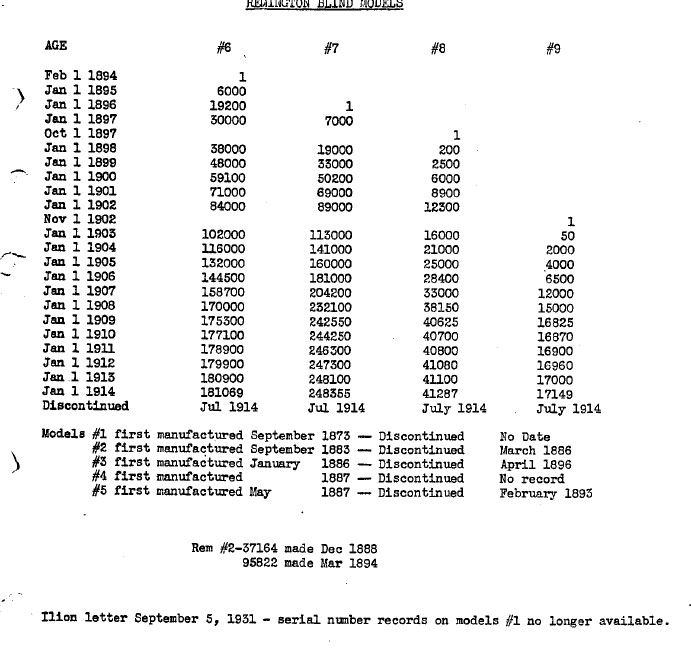
And one compiled from an Illon Factory Letter of January 24, 1930:
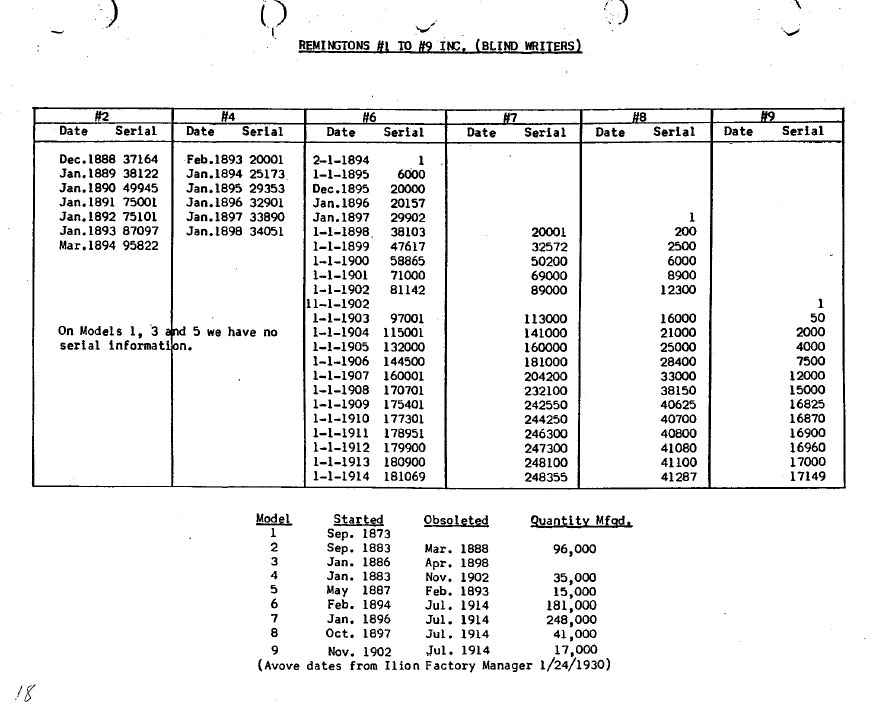
The third is a later-generation photocopy of the second, with notes on other machines added by later collectors, it can be ignored for now. These two tables between them provide a clear and mostly complete picture of the production run of Model #’s 6,7,8 and 9 and declare that no records for the #1 existed by 1930. Information on Model #’s 2,3,4 and 5 are sketchy at best.
To fill in the gaps, I printed out *all* of the information I have on Remington so I could read it on paper and mark it up with a pencil. I can’t read detailed stuff on a screen, and can’t mark up my expensive typewriter reference books, so I copy the relevant sections and staple them into easily-digestible chunks. Remington info isn’t exactly scarce, so this is what it looks like when I sat down to breathe it all in:
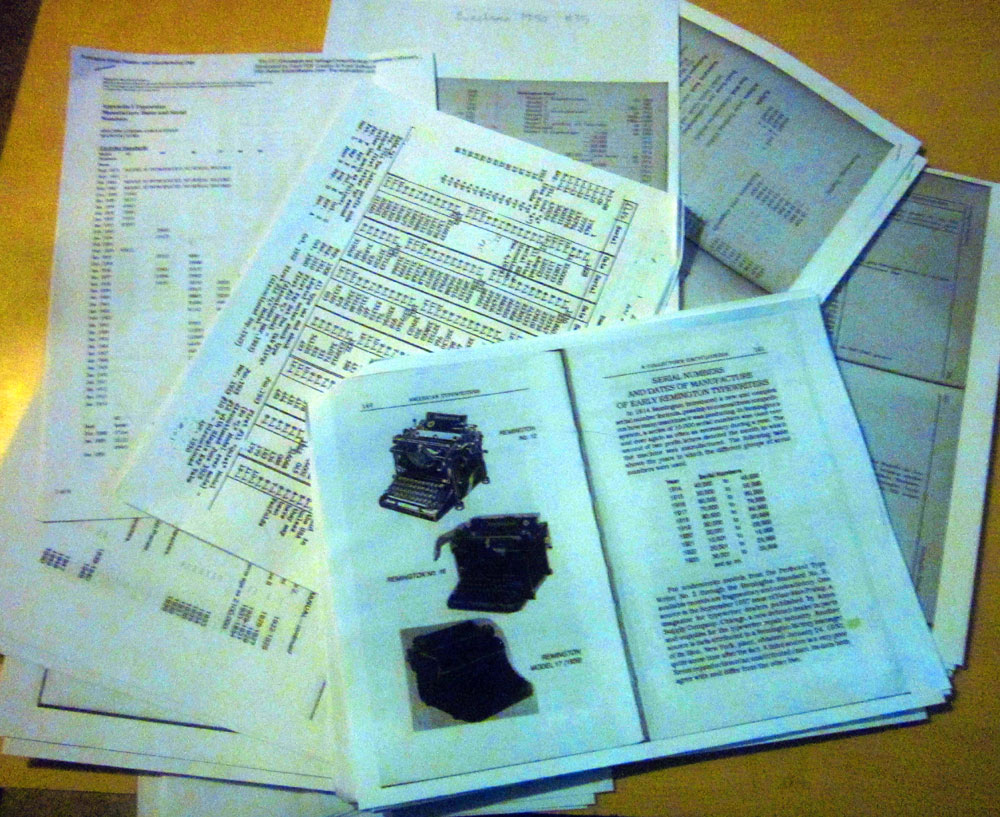
I started with the Secondary Sources, lists compiled by dealers associations such as NOMDA, OMEF, Shipman-Ward, SCM and the various “Liste der Herstellungsdaten”. Even the oldests of these sources, the 1941 Otto Hoffman List, treated Remington blind writers with only the sketchiest of detail, ignoring most early blind models completely. They were only helpful in providing very general confirmation of Source #18’s date ranges.
Adler and Beeching tell a narrative of early Remingtons without proving any detail about serial numbers, and the Hagley Museum compilation of Remington serial numbers kept at MoLG appears to just be a re-typing of the Illion Letter of 1/24/30, and was thus redundant. It was only when I started reading the Remington section of Lippman’s “American Typewriters” that the pieces fell into place.
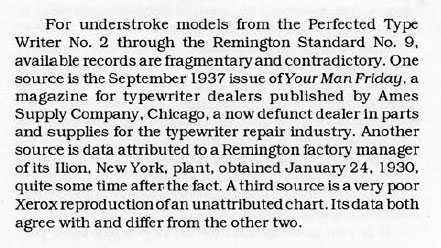
Here’s where the bells went off: One of Lippman’s sources was the very same Illion Factory letter 1/24/1930 that was used to compile the second table in Source #18. Lippman apparently didn’t have access to the 9/5/1931 letter, and so his tables lack the expanded information contained in that first #18 table, but he did have access to two other sources I lack: The September 1937 issue of Ames’ “Your Man Friday” and the unattributed “very poor Xerox copy” document. He goes on to build a very good serial number list for Model #’s 2,4,5,6,7,8 and 9 using the data from all three lists, neatly dovetailing them together (and importantly, including the data from all 3 lists).
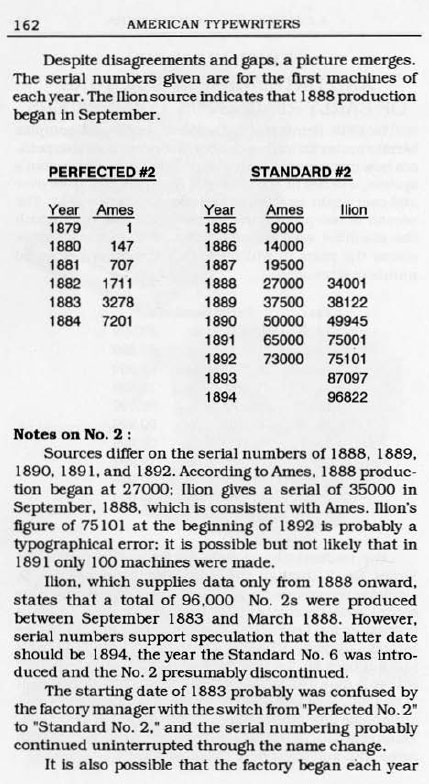
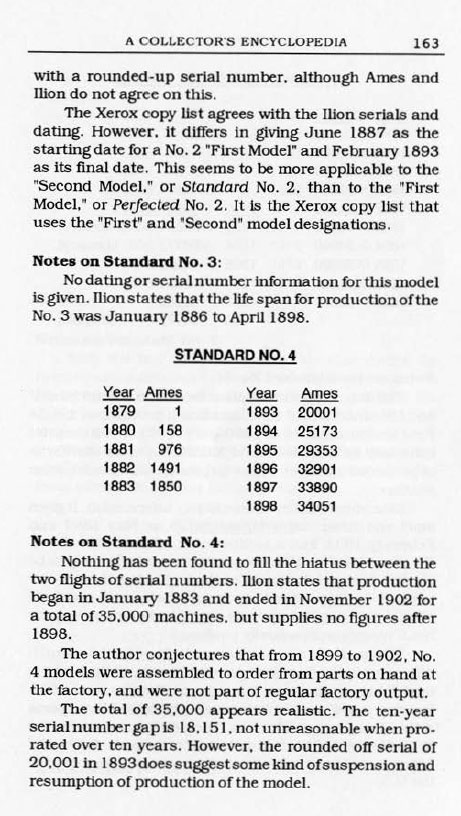
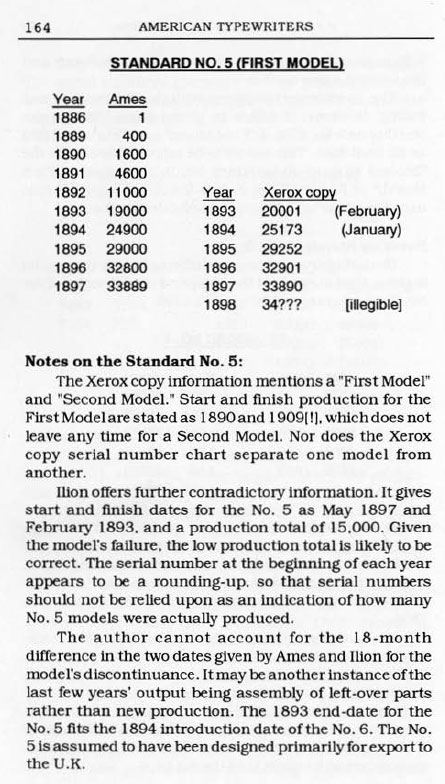
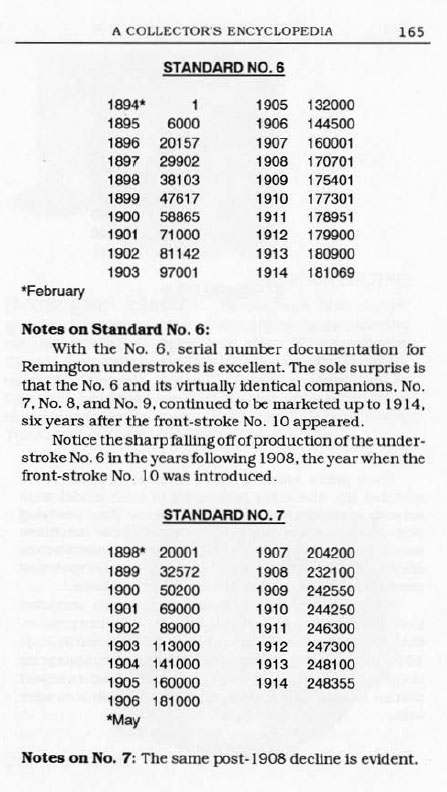
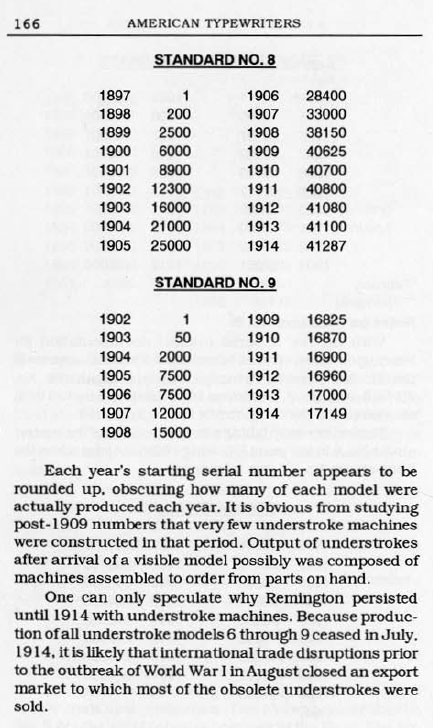
Lippman’s conclusions validate Source #18 so well that in the end I went with the Ilion 9/5/1931 tables from #18 for most of the data, supplementing it with data unique to Lippman’s tables (primarily the serial number list for the #2 and #4 – the old TW-DB numbers turned out to be December 31st numbers and somewhat off – if you dated your Remington #2 with that list, you’re probably a year off date.)
The hunt is still on for lists for the model #1 and #3 Blind Writers, although I have little hope that will bear fruit. In the meantime, I’ve started in on the Remington Frontstrike Standards (Non-noiseless) and have almost all of that section in. Note the massive amount of page space it takes, and ponder a moment an equally large section of Noiseless serial numbers, a much larger section of Portables (noiseless and non-noiseless) then a section on Rebuilds and a pretty sizable one on Electrics, and you’ll get why it’s gonna take me a few weeks to chew through this. :D
PS: I also rebuilt part of the Olivetti page, BTW, we got new data on the oldest Olivettis, a few years worth of Italian-made Graphikas and confirmation that Olivetti liked to put out their serial lists as DEC 31 numbers, and thus it’s very, very, very likely that *all* of the Olivetti numbers are DEC 31, not JAN 1. Le sigh. :P
UPDATE: Regarding the Remington Blind Writers, I went through my resources again and discovered that Source #31 ( The Business Machines and Equipment Digest, publ. 1927 by Equipment-Research Corporation, copy contributed by Mark Adams) happens to have a very detailed section in the “Serial Numbers” chapter on Remington Blind Writers. Understandably so, as it was just 1927 – and this might be the oldest verified serial number list for Remington.
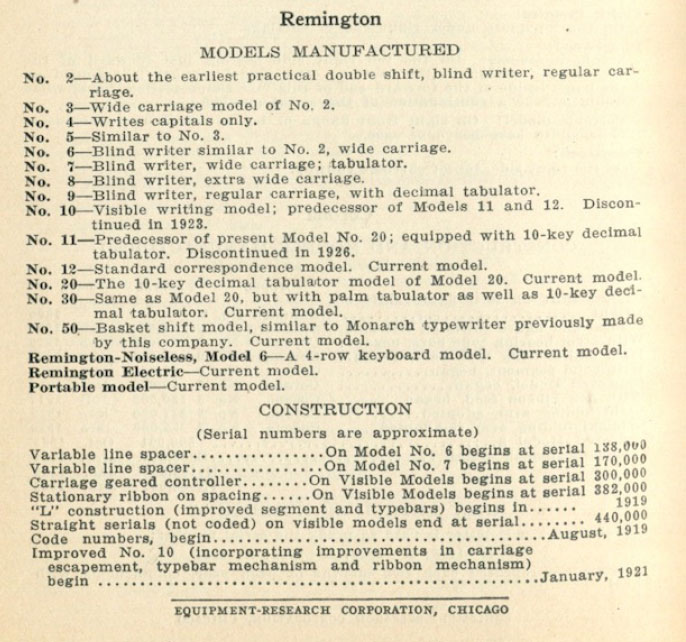
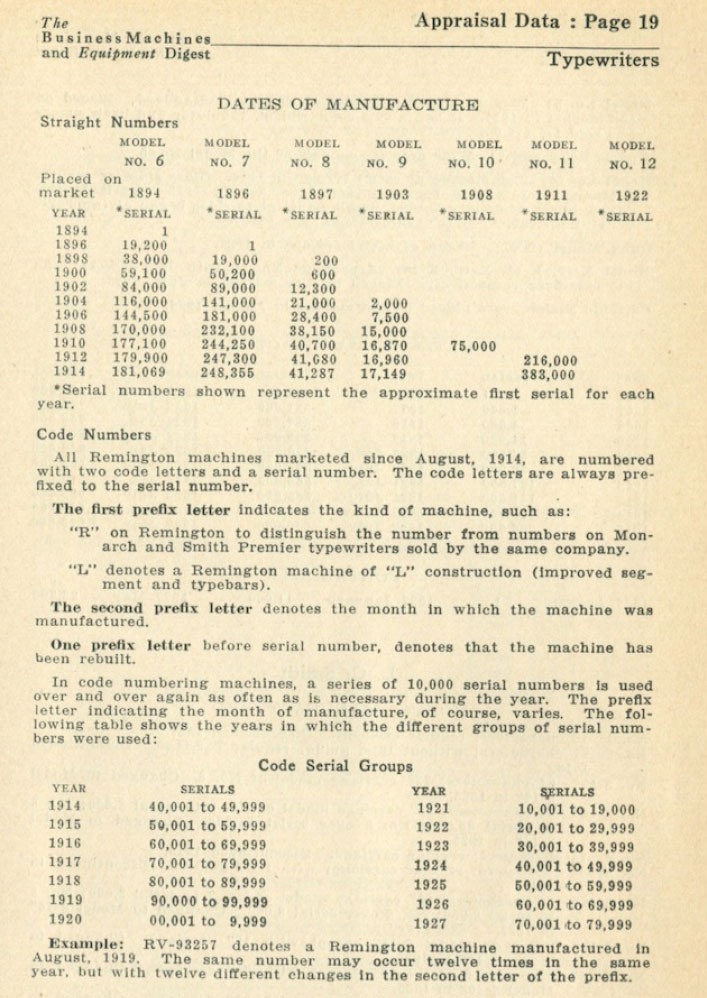 And guess what? Although this list only shows even numbered years, the numbers match the Source #18 “Ilion 09-05-1931” list exactly, and the text verifies Source #18’s other assertions about the extremely weird serial numbering systems Remington tried out between 1914 and 1928 for their Frontstroke models, and also validated an assumption I made about the numbering cycle in 1926/7/8 repeating the same numbers and prefix as 1916/7/8 (and thus raises the question: “Can you actually distinguish a 1917 machine from a 1927 machine by serial number?”). Basically, point by point it validates Source #18 and by extension, Paul Lippman’s lists as well.
And guess what? Although this list only shows even numbered years, the numbers match the Source #18 “Ilion 09-05-1931” list exactly, and the text verifies Source #18’s other assertions about the extremely weird serial numbering systems Remington tried out between 1914 and 1928 for their Frontstroke models, and also validated an assumption I made about the numbering cycle in 1926/7/8 repeating the same numbers and prefix as 1916/7/8 (and thus raises the question: “Can you actually distinguish a 1917 machine from a 1927 machine by serial number?”). Basically, point by point it validates Source #18 and by extension, Paul Lippman’s lists as well.
Oh, and one other thing: I was mystified by a reference in Source #18 that indicated “Spool-O-Wire first made” in late 1926. I had no idea what a “Spool-O-Wire” was, but I dutifully noted it in the section on the Standard #10. Well, today I found out what a “Spool-O-Wire” is (it’s a stapler that cuts staples from a spool of wire) and confirmed they were first made in the Remington Ilion plant around 1926/7:
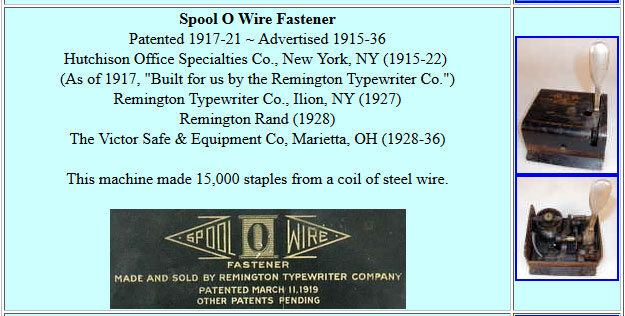 So Source #18 is looking pretty good, accuracy-wise, and getting better the more I dig into it. For instance, I mention Source #18’s references to “Ilion Letters” in the above post, and mentioned two or three by date. There’s more… A lot more than I suspected at first glance. As I pour through the data, I’ve been making a special effort to note down all references to specific Remington dated or named literature. I’m about halfway through this search and have counted some 26 distinct official dated Remington documents used as references. This source really had to have been compiled by someone who had direct access to stacks of official Remington manufacturing and sales data that ranged between about 1930 to around 1973. I really wish I knew who it was that compiled this data together. They appear to have done a rather epic job of it. (:
So Source #18 is looking pretty good, accuracy-wise, and getting better the more I dig into it. For instance, I mention Source #18’s references to “Ilion Letters” in the above post, and mentioned two or three by date. There’s more… A lot more than I suspected at first glance. As I pour through the data, I’ve been making a special effort to note down all references to specific Remington dated or named literature. I’m about halfway through this search and have counted some 26 distinct official dated Remington documents used as references. This source really had to have been compiled by someone who had direct access to stacks of official Remington manufacturing and sales data that ranged between about 1930 to around 1973. I really wish I knew who it was that compiled this data together. They appear to have done a rather epic job of it. (:
You are heroic and scientific at once!
I’ll get that remaining Remington info to you within a week.
Holy F!!!!
Ted, I dont envy you but im glad iit’s you since you seem dedicated on getting this work right. The effort will be remembered, my friend.
Sure is a tremendous amout of searching, comparing and work. I’m glad you are up to the task. You are providing a truly valued service to the Typosphere.
The process reads like a court case with inferences, probabilities and documentation which all relate to facts which are, in this instance, preserved in iron. I admire your application to the task!
A very under-appreciated, tedious task, I must say. You have my admiration and best wishes my friend.